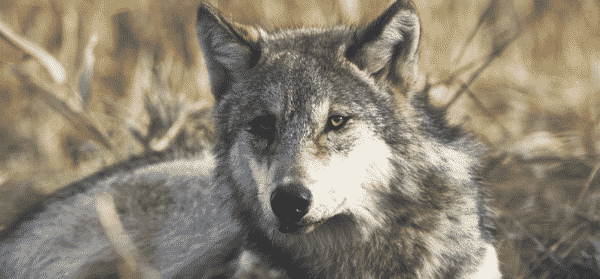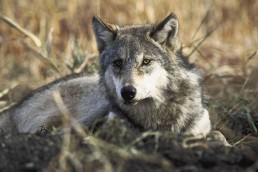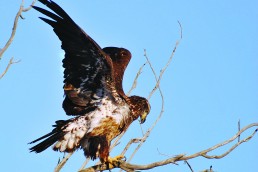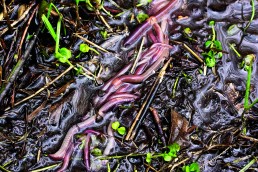Rarities, Deadly Dangers, and Survival
SHARE THIS POST
A ‘gray’ area
Not many species when added to the endangered species list make a full recovery. The bald eagle is an exception, and has made an incredible recovery. We are in the process of watching another species make a recovery. Surrounded by folklore and bad publicity, the gray wolf is bouncing back.  In 1974, gray wolves were added to the endangered species list, with their extirpation documented in many regions. Many were killed in response to their negative impact on the numbers of large-game herds. Bounties were paid for killing wolves, which accelerated their extirpation, boosting the motivation to kill them. States like Wisconsin acted late, banning the killing of wolves after the wild canines had already been completely eradicated from the area. Once it was realized wolves were in need of serious help, no time was wasted in restoring populations as they were reintroduced to states that formerly had native populations. It did not take long for wolf populations to exceed what was expected. While gray wolves may not be in all the states they once were, populations are well on their way to a full restoration.
In 1974, gray wolves were added to the endangered species list, with their extirpation documented in many regions. Many were killed in response to their negative impact on the numbers of large-game herds. Bounties were paid for killing wolves, which accelerated their extirpation, boosting the motivation to kill them. States like Wisconsin acted late, banning the killing of wolves after the wild canines had already been completely eradicated from the area. Once it was realized wolves were in need of serious help, no time was wasted in restoring populations as they were reintroduced to states that formerly had native populations. It did not take long for wolf populations to exceed what was expected. While gray wolves may not be in all the states they once were, populations are well on their way to a full restoration.
Too much or not enough H20?
Winter kill-offs frequently occur in lakes and ponds in the northern reaches of the Midwest. The most common reason is there’s not enough sunlight reaching the aquatic vegetation, ending photosynthesis. When photosynthesis is cut off, oxygen isn’t produced, killing the fish. In some scenarios, however, the opposite occurs. An absence of snow on the ice makes it possible for the vegetation to produce too much oxygen. Usually, snow on ice can limit the oxygen fish need. Oxygen taken in by fish is “dissolved oxygen,” and is measured in parts per million (ppm). Fish prefer 5 ppm, but at around 1 to 2 ppm it becomes a life-threatening scenario for fish. Populations can be hurt, but it does not mean the lake will become devoid of life. These die-offs are natural and are dictated by the severity of that winter. Do not be overly alarmed, as these lakes do recover.
Good-looking, and deadly
Some of the best-looking flora in the Midwest isn’t always native. Often, they’re brought here away from their native range to add to the scenery. This is how purple loosestrife (Lythrum salicaria) arrived in the Midwest. A plant native to Asia, Europe, Australia and Africa, purple loosestrife was brought over by European settlers in the 1800s. In North America, 40 states currently have it as well as all Canadian provinces bordering the U.S.
Some of our wetlands have been completely taken over by this exotic plant, especially in the East. When loosestrife takes hold, a change in the water flow occurs, lessening the biological diversity in that area. These plants grow quickly too, smothering native flora. Loosestrife is a taller plant with 6 feet at maximum height. Its attractive purple flowers feature a yellow center, but these blooms do come at a cost.
Are you enjoying this post?
You can be among the first to get the latest info on where to go, what to use and how to use it!
‘Small’ distinctions
Drive along any country road and you can identify many birds of prey. Red-tailed hawks and bald eagles are easily identifiable when seen soaring over the landscape or on a telephone pole. Our smallest raptor, the American kestrel, may be harder to see. This bird belongs to the falcon group and is the most common falcon species. Kestrels are dwarves stacked up against most other raptors, with a maximum wingspan of only 24 inches and a total body length of 12 inches. Its small size enables it to have broader dietary habits, eating critters as small as grasshoppers, but they can also attack squirrels. Their unique pattern allows for quick identification too, especially since you can use their smaller size as an identification tool. Males have more vibrant colors and clearer patterns than females. Males feature bluish-gray wings with black spots, while females have brown wings with black spots. The male’s back is orange-brown with black spots, while a female’s back is brown with black spots. The male’s underside is white and has black speckling while the female’s is the same, but their speckling is brown. The male has a blue head and the female has a brown one. Tail feathers vary too, with a male’s tail matching its back in color with black bars at the bottom edge. Tails feathers on females are brown with black bars running horizontally. Considering the number of distinct features, correctly distinguishing males from females shouldn’t be too hard, if you can spot one.
Something special lies below
Hiding within every habitat are species seldom seen. A common Midwest habitat, the bog or fen, contains unique biota unlike any other. Inside the moss mats and murky water exists a strange salamander that is one of a kind. The four-toed salamander, Hemidactylium scutatum, has a unique taxonomy in that they are the sole species within the entire Hemidactylium genus. To identify one, the underside is white with black splotches, similar to the stereotypical “cow pattern.” The back is an orange-brown, while their sides are gray. This salamander’s tail is noticeably lighter than the rest of its body. Its stout, stubby face is another unique feature. Four-toes are present throughout the region, but has numerous disjunctive populations. It’s rare and special to see one, and anyone who does should consider his or herself lucky.
Black widow of the north
The Midwest isn’t home to many venomous animals. The obvious species, such as copperheads and rattlesnakes, get our attention. But our spiders with their toxic bites are sometimes forgotten. One of the most infamous is found surprisingly far north. Black widows can inhabit areas here and into Canada. They are increasingly uncommon the farther north you go, but rather than worry about them, it’s better to be aware. Only the females have the ability to really envenomate someone, and their bite rarely causes fatalities despite thousands being bitten every year. Females are easily identifiable with the traditional black body with a red hourglass shape on the underside. Males are brownish and have much longer legs than the females, and a smaller abdomen. Shaking out your old boots in the shed is never a bad idea.
MWO
SHARE THIS POST
Did you enjoy this post?
You can be among the first to get the latest info on where to go, what to use and how to use it!
Calvin Vick
MidWest Outdoors’ “Nature Notes” columnist Calvin Vick is an undergraduate studying biology, with an emphasis on herpetology, at the University of Central Arkansas. His primary interests are venomous snakes and salamanders. He spends most of his free time photographing the two.



